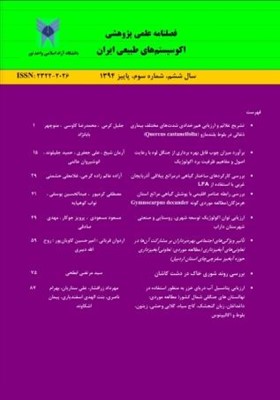بررسی روند شوری خاک در دشت کاشان
محورهای موضوعی : جنگلداری
1 - استادیار پژوهش، بخش تحقیقات منابع طبیعی، مرکز تحقیقات و آموزش کشاورزی و منابع طبیعی استان اصفهان، سازمان تحقیقات، آموزش و ترویج کشاورزی، اصفهان، ایران،
کلید واژه: کیفیت آب, تخریب خاک, بیابانزائی, آبهای زیرزمینی, پایش,
چکیده مقاله :
دشت کاشان از جمله مناطقی است که به جهت واقع شدن در حوزه آبخیز مرکزی و شرایط اقلیمی نامناسب، از پتانسیل تولیدی بسیار پائین برخوردار است. بهره برداری بیرویه از منابع طبیعی بخصوص در سالهای اخیر باعث افزایش تخریب خاک و گسترش بیابان شده است. در این تحقیق عوامل موثر بر گسترش این فرایند نامطلوب که در آن منابع آب و خاکی از جایگاه ویژه ای برخوردارند، مورد مطالعه قرار گرفت. تغییرات شوری خاک در گستره دشت کاشان با حفر 8 نیمرخ با عمق متوسط 5/1 متر طی 5 سال (1386-1382) بررسی گردید. این عرصه ها با در نظر گرفتن پراکنش و نوع کشت و آبیاری انتخاب گردیدند بطوری که خصوصیات اصلی آب و خاک کل دشت کاشان را عرضه نمایند. نمونه های آب و خاک از هر افق خاک در پایان سال زراعی در اواخر شهریور ماه برداشت و در آزمایشگاه مورد تجزیه قرار گرفت. نتایج نشان داد که روند تغییرات شوری در 3 عرصه افزایشی، 2 عرصه ثابت و 3 عرصه دیگر کاهشی است. اگر به طور متوسط هر عرصه مبین خصوصیات 5/12 درصد کل دشت باشد، افزایش شوری و تخریب خاک در 5/37 درصد مساحت دشت کاشان در حال رخ دادن است. بیشترین هدایت الکتریکی خاک و آب به ترتیب معادل 1/30 و 73/17 دسی زیمنس بر متر در عرصه صالح آباد و کمترین آن معادل 7/2 و 98/2 دسی زیمنس بر متر در عرصه محمدیه مشاهده شد.
Kashan plain located in central of Iran and its climate is arid. Population growth and increasing demand new sources, it is endangering the fragile ecosystems. Reduced agricultural production, abandoned agricultural land and desertification phenomena which appear in Kashan plain is clearly visible, the evidence for this claim. In this study, the factors affecting the spread of undesirable process in which water and soil have been studied. Changes in soil salinity and alkalinity in the Kashan plain area by drilling 8 profiles over 5 years. The results showed that increasing salinity changes at three sites, two fixed sites and 3 sites is decreasing. Therefore, increasing the salinity and soil degradation in the 5/37% of the area of Kashan plain is about to happen. The maximum EC of soil and water respectively was observed 30.1 and 17.73 dS/m site in Saleh Abad and least equal to 2.7 and 2.98 dS/m at the Mohammadia site. In order to maintain the status quo, changing the irrigation, cultivation of plants with low water needs, the use of alternating high and low water quality, flood spreading systems for the use of water in the upstream and prevent the drilling deep and uncontrolled exploitation of groundwater is proposed to Kashan plain.
references
- Darvish, M., M. Khosroshahi, H.R. Abbasi, Pakparvar, M. and F.Khaksarian, 2009.Monitoring of soil salinity and alkalinity as a process of desertification. Forest and range journal, 81: 72-80.
- Eilers, R.G., Eilers, W.D. and M.M. Fitzgerald,1997. A salinity risk index for soils of the Canadian Prairies. Hydrogeology Journal, 5:68–79.
- Feng, Z., Wang, X. and Z. Feng, 2005. Soil N and salinity leaching after the autumn irrigation and its impact on groundwater in Hetao Irrigation District. China. Agricultural Water Management, 71: 131-143.
- Garcia, L.A. 2004. Field Scale Monitoring and Modeling of Salinity. Research project No. COL00736, Colorado State Uni., Web published in: http://www.colostate.edu/Depts/AES/projs/736.html
- Herrero, J. and C. Castañeda, 2013. Changes in soil salinity in the habitats of five halophytes after 20 years. CATENA 109: 58-71. DOI: 10.1016/j.catena.
- Kitamura,Y., Yano, T. Honna, T. Yamamoto, S. and K. Inosako, 2006. Causes of farmland salinization and remedial measures in the Aral Sea basin-research on water management to prevent secondary salinization in rice-based cropping system in arid land. Agricultural water management 85:1 – 14.
- Manjunatha, M.V., Oosterbaan, R.J., Gupta, S.K., Rajkumar, H. and H.Jansen, 2004. Performance of subsurface drains for reclaiming waterlogged saline lands under rolling topography in Tungabhadra irrigation project in India. Agricultural Water Management, 69: 69-82.
- Masoud, A.A. and K. Koike,2006. Arid land salinization detected by remotely-sensed landcover changes: A case study in the Siwa region, NW Egypt. Journal of Arid Environments, 66: 151–167.
- Pozdnyakova, L. and R.D. Zhang, 1999. Geostatistical analyses of soil salinity in a large field. Precision Agriculture, 1: 153–165.
- Qureshi, A.S., McCornick, P.G., Qadir, M. and Z. Aslam, 2008. Managing salinity and waterlogging in the Indus Basin of Pakistan. Agricultural Water Management, 95: 1-10.
- Qadir, M., Qureshi, R.H. and N.Ahmad,1998. Horizontal flushing: a promising ameliorative technology for hard saline-sodic and sodic soils. Soil & Tillage Research, 45: 119-131.
- Ward, P.R., Fillery, I.R.P., Maharaj, E.A. and F.X. Dunin, 2003. Water budges and nutrients in a native Banksia woodland and an adjacent Medicago sativapasture. Plant and Soil. 257: 305–319.
- Jafari, M., H. Azarnivand, Gh.R. Zehtabian and A.Jamshidi, 2002. Role of irrigation water quality on the agricultural land margin of Damghan. Desert Journal, 7(2):121-128
- Khorasani Zadeh, H, 2007. Comparative study of urban and agricultural water use in terms of quality and quantity and the impact of harvesting on water resources and how to predict the future in Kashan. Report of project, Water and sewage company, Kashan, 252pp.
- Mashhadi, N. and M. Karimpour Reihan, 1997. Salinity of soil and water and their relation with the desertification. Forest and range journal, 35:50-56.
- Pakparvar, M. 2004. The final report of project: changes the properties of the soil and water in the lands of the garmsar. Research Institute of forests and rangelands, 189pp.
- Zehtabian, Gh.R., A, Khalilpour and M.Jafari. 2002. Aquifer degradation due to over use of ground water (case study: plain of Qom). Desert journal, 7(2): 99-120


